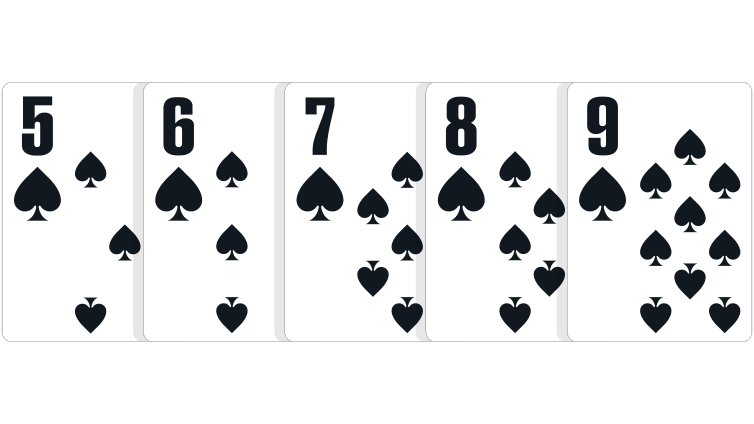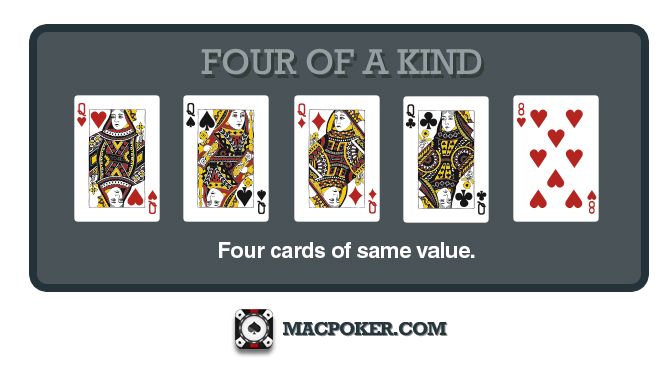Three cards of the same rank, and two cards of a different, matching rank. In the event of a tie, the highest three matching cards wins.
In this section you will be the basic knowledge you need to play Omaha at its most simple level.Nine or ten players is customary in Omaha high-low split, which has a rotating blind system (meaning for every
 hand, a certain player must contribute a set amount of money to start the betting). Usually a score of eight or better is placed on the low hand, and the best high hand will split the pot with the best low hand. This means for a hand to qualify as a low, it must have five cards not paired that are ranked eight or lower. For example, a hand consisting of ace, two, three, seven, and eight qualifies as a low hand; but a hand of ace, two, three, seven, and nine does not.
hand, a certain player must contribute a set amount of money to start the betting). Usually a score of eight or better is placed on the low hand, and the best high hand will split the pot with the best low hand. This means for a hand to qualify as a low, it must have five cards not paired that are ranked eight or lower. For example, a hand consisting of ace, two, three, seven, and eight qualifies as a low hand; but a hand of ace, two, three, seven, and nine does not.©2006 Publications International, Ltd. This hand would qualify as the low hand in Omaha high-low split. |
 Each player is dealt four down cards, called 'hole' cards. Then three community cards are dealt face up in the center of the table. These cards are called the 'flop
Each player is dealt four down cards, called 'hole' cards. Then three community cards are dealt face up in the center of the table. These cards are called the 'flopOmaha Poker Low Hand Rules
.' Another card is dealt face up, which is called the 'turn,' followed by the last card being dealt face up, called the 'river.' Rounds of betting are before the flop, after the flop, after the turn, and after the river.Each player must use exactly three cards from the five community cards and two from his/her hand in any combination to form a high hand and/or a low hand. The same five cards do not have to be used for the high and the low. Note that if there are not at least three community cards ranked eight or below, there will be no low hand, and the entire pot will be awarded to the best high hand. The two most important rules are: (1) Each player must use exactly three community cards and two hole cards; (2) the order of ranking for low hands is from the highest of the five cards.
The easiest way to rank low hands is to read them backward as a number with the lowest number winning. For example: 2-3-4-6-8 would be read 8-6, 4-3-2 and 3-4-5-6-7 would be read 7-6, 5-4-3, which would be the lower of the two hands. Many times two players will have the same low hand and split the low half of the pot. This is often called 'getting quartered.'
Omaha/8 games, especially on the Internet, are filled with players who don't know how to play the game. Almost all Omaha/8 players are current or former Texas Hold'em players who use the same thought process and mentality while playing Omaha/8 as when they played Hold'em. This is why Omaha/8 can be profitable. Because there are four hole cards instead of two, many players think they see more possibilities to win and thus play far too many hands.
Another weakness in the games of many beginning players is not folding after the flop when the only hope they have is a split pot or a runner-runner (that is, needing the turn and river cards to win, which is a statistically weak position) to make their hand. In Omaha, after the flop, your hand is well defined. You see 7 out of the 9 cards you will use -- almost 80 percent. In contrast, after the flop in Hold'em you have seen only 5 of 7 cards, which is just over 70 percent. Omaha/8 tends to be a much more straightforward and mathematical game than Hold'em.
For this reason, Omaha/8 tends to have less short-term variance (luck) than Hold'em. Many players enjoy playing Omaha/8 more than Hold'em because of the reduced variance. The problem is it can sometimes be hard to find a good Omaha/8 game, but there never seems to be a shortage of Hold'em games.
An important skill to master in Omaha/8 is reading the cards. You must be able to look at the cards and consider what the best possible hand is, the likelihood of someone having the best hand, how close your hand is to the best hand, and what chance you have to improve to the best hand. As will be discussed shortly, you must often have the best hand possible to win. Reading the cards is a skill that will become easier as you gain experience. A good way to improve your skills is to read the cards on every hand even when you have folded. This not only will improve your skills but also will help you learn what types of hands your opponents are playing. You need to determine if there is a possible low, if there is a possible flush -- five cards of the same suit in order, if there is a possible straight (which will be possible on most hands) -- five cards of any suit in order, and if there is a possible full house (whenever the board shows one or two pairs, players probably have a full house) -- three of a kind and two of a kind.
Now that we've covered the basics, it is important to discuss what to do after the cards are dealt. In the next section we will discuss one of the most important aspects of any poker game: starting hand selection. What cards should you play and which should you fold?
Basic Rules Of Omaha Poker
For more information on Omaha poker and other variations, try the following links:Omaha Poker Rules High Low
- To see all of our articles on poker rules and advice, go to our main article on How To Play Poker.
- Before you play your first hand, make sure you're familiar with some Poker Basics.
- For the more common form of Hold 'Em, what you want is to know How to Play Texas Hold 'Em Poker.
- Feel more like playing an old favorite. Knowing How to Play 7-Card Stud Poker will take you back a few years.